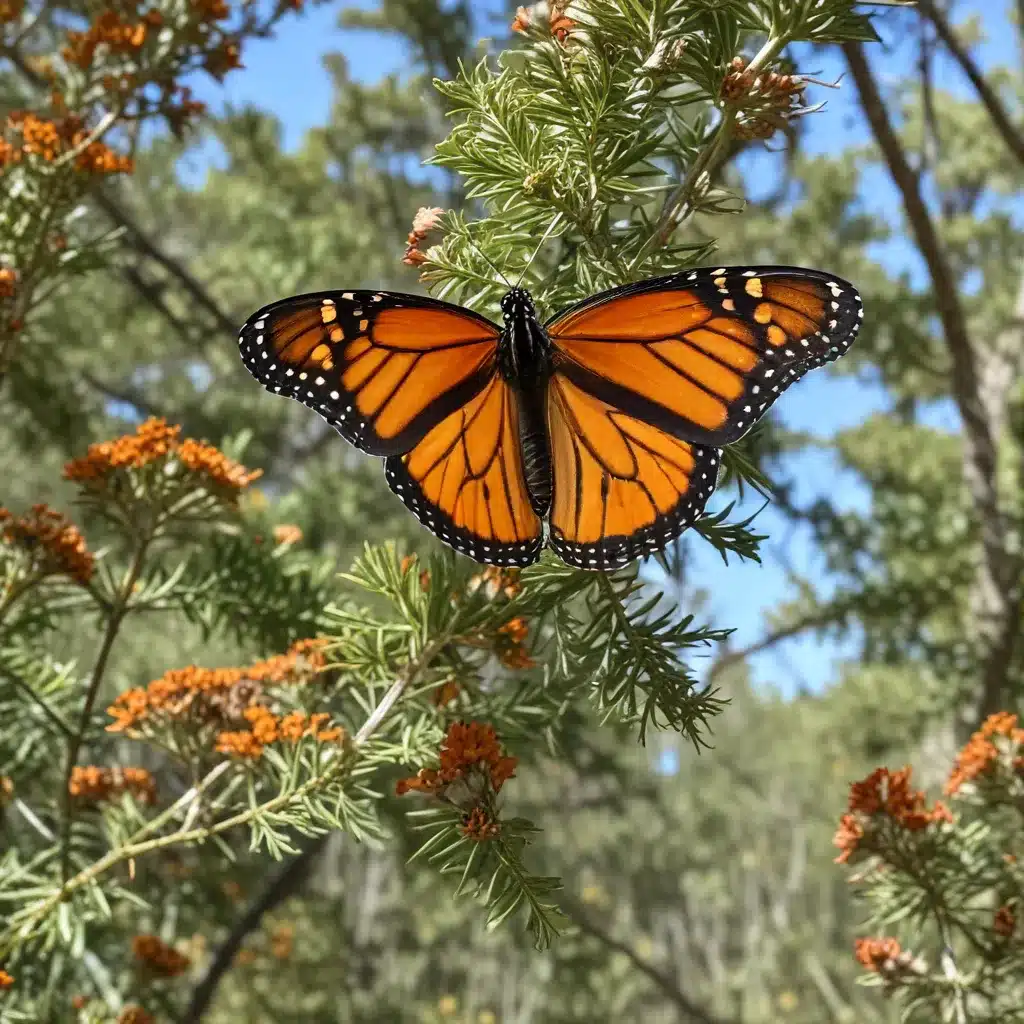
The undulating waves of delicate orange wings against a backdrop of towering pine trees and rugged mountains—this is the mesmerizing sight that welcomes visitors to Crooked Pines Farm each fall. From September through November, our peaceful corner of the Pacific Northwest transforms into a renowned destination for witnessing one of nature’s most captivating phenomena: the annual migration of the monarch butterfly.
Monarch Butterfly Characteristics
The monarch butterfly (Danaus plexippus) is easily recognized by its distinctive orange and black patterning. These medium-sized butterflies have a wingspan of 3-4 inches and can live for up to 6-8 months, thanks to their unique migration and overwintering behaviors. Monarchs undergo a complete metamorphosis, transitioning from an egg to a striped caterpillar, then forming a jade-green chrysalis before emerging as the vibrant adult butterfly.
Monarch Butterfly Habitats
Monarchs are found across much of North America, with breeding grounds stretching from southern Canada down through the central United States. However, the iconic western monarch population that graces our region has a more limited range, breeding west of the Rocky Mountains and overwintering along the Pacific coast. Each spring, these monarchs leave their coastal sanctuaries and embark on a northward journey, eventually reaching their summer breeding grounds.
Monarch Butterfly Migration Patterns
The western monarch migration is a marvel of natural engineering. These delicate insects navigate hundreds of miles, using environmental cues like the position of the sun and the earth’s magnetic field to guide their way. Their journey is timed to coincide with the availability of their primary host plant, the milkweed, which provides food and shelter for monarch caterpillars.
Favorable weather conditions are essential for a successful migration. Monarchs require warm, gentle breezes to carry them aloft, and they must avoid extreme temperatures or severe storms that could disorient or exhaust them. Changing climates pose a significant threat, as monarch populations have already faced steep declines in recent decades due to habitat loss and disrupted migration patterns.
Crooked Pines: A Monarch Butterfly Destination
Situated in the heart of the Pacific Northwest, Crooked Pines Farm occupies a prime location along the western monarch’s migratory path. Our diverse habitat, which includes lush meadows, towering pines, and sheltered ravines, provides an ideal stopover and overwintering site for these remarkable butterflies.
Each fall, monarch scouts begin to arrive at Crooked Pines, scouring the landscape for the perfect roosting spots. As the season progresses, their numbers swell into the thousands, with monarchs clustering in the upper branches of our towering Douglas firs and ponderosa pines. The sight is simply breathtaking, as the monarchs’ vibrant wings create a mesmerizing dance against the evergreen backdrop.
Monarch Butterfly Observation and Conservation
Visitors to Crooked Pines are treated to unparalleled opportunities to witness the monarch migration up close. We’ve established a network of nature trails that wind through the prime monarch habitat, allowing guests to observe the butterflies without disturbing them. Our farm educators are on hand to share fascinating insights about monarch biology and the crucial role they play in our ecosystem.
Beyond providing a premier monarch viewing experience, Crooked Pines is deeply committed to monarch conservation. We actively manage our land to maintain and enhance monarch breeding and overwintering sites, ensuring that these magnificent butterflies have the resources they need to thrive. We also partner with local organizations to support research and citizen science initiatives that track monarch populations and migration patterns.
The Importance of Monarch Butterfly Migration
Monarch butterflies are more than just a captivating sight—they are integral components of healthy ecosystems. As pollinators, monarchs play a vital role in the reproduction of countless plant species, transferring pollen as they flit from flower to flower. Their remarkable migration also connects disparate habitats, serving as an important indicator of environmental health across the continent.
Culturally, monarchs hold deep significance for many Indigenous communities, who have long revered these butterflies as symbols of transformation, rebirth, and the interconnectedness of all living things. The annual monarch migration has also inspired countless works of art, literature, and scientific study, captivating the human imagination for generations.
Threats to Monarch Butterfly Migration
Despite their importance, monarch populations have faced alarming declines in recent decades. Habitat loss, particularly the destruction of milkweed plants and overwintering groves, has taken a devastating toll. Climate change also poses a grave threat, as shifting weather patterns disrupt the delicate timing of the monarch’s migration and breeding cycles.
Addressing these challenges requires a multi-faceted approach, involving habitat restoration, agricultural practices that support monarch populations, and continued research and monitoring. At Crooked Pines, we’re doing our part by educating visitors, implementing sustainable land management strategies, and collaborating with partners to safeguard the future of these remarkable insects.
Monarch Butterfly Migration Research and Monitoring
The study of monarch migration is an active field of research, with scientists around the world working to unravel the mysteries of this annual phenomenon. At Crooked Pines, we’re proud to host visiting researchers who use our farm as a field site for their studies, tracking monarch populations, documenting their behaviors, and investigating the environmental factors that shape their migration.
We also encourage our visitors to participate in citizen science initiatives, such as tagging programs and migration monitoring projects. By engaging the public in data collection, these efforts not only contribute to our scientific understanding of monarchs but also foster a deeper appreciation for the wonder of their migration.
As you wander our nature trails and witness the monarchs alighting on the branches above, take a moment to appreciate the incredible journey that has brought them here. These delicate creatures have navigated countless miles, defying the odds to reach this special place. By preserving and protecting their habitat, we can ensure that the mesmerizing migration of the monarch butterfly continues to captivate and inspire us for generations to come.


